Zn-Co-CeO2 vs. Zn-Co Coatings: Effect of CeO2 Sol in the Enhancement of the Corrosion Performance of Electrodeposited Composite Coatings
Abstract
1. Introduction
2. Materials and Methods
3. Results and Discussion
3.1. Characterization of Plating Solutions
3.2. Morphology and Composition of Zn-Co and Zn-Co-CeO2 Coatings
3.3. Surface Roughness Determination
3.4. X-ray Diffraction Analyses
3.5. Polarization Tests and Electrochemical Impedance Spectroscopy
3.6. Scanning Kelvin Probe (SKP) Surface Scan of Coatings
3.7. SKP Line Scans of Coating with Artificial Defect
4. Conclusions
- −
- The ceria sol proved to be superior as a particle source in the plating solution compared to commonly used commercial powder, in terms of dispersity and stability of the plating solution.
- −
- The use of ultrasound agitation failed at effectively de-agglomerating the commercial powder particle clusters. The size of the particle diameter (94.9% abundance) was 4979 nm.
- −
- The ceria particles incorporated into the Zn-Co matrix caused morphological changes and refinement of grain sizes. The changes in morphology were more obvious when ceria sol was used; the cauliflower-like structures were replaced by more uniform and compact coral-like structures. The size of cauliflower-like agglomerates of alloy grains was reduced from 30 µm to 2 µm when ceria powder was incorporated into the matrix. When ceria sol was used as a particle source, coral-like forms with a size of about 500 nm were obtained. The incorporated particles were distributed homogeneously throughout the coating, as confirmed by mapping. The electrodeposition from the solution containing ceria sol was beneficial for ceria content, homogeneous distribution of particles in the deposit and finer surface finish (lower roughness and better compactness) of the coating.
- −
- The performed electrochemical tests, i.e., polarization tests, EIS and SKP, showed that Zn-Co coatings doped with ceria particles during ultrasound-assisted electrodeposition possess protective properties either in terms of barrier or self-healing activity.
- −
- The Zn-Co-CeO2 (CeO2 sol) composite coating showed superior protective properties compared to Zn-Co-CeO2 (CeO2powder) coating as a result of compact and uniform morphology as well as higher ceria content that proved to be an efficient self-healing agent. The corrosion current density of Zn-Co-CeO2 (CeO2 sol) composite coating was lower and the Rct value four times higher compared to Zn-Co-CeO2 (CeO2 powder) coating.
- −
- The SKP surface scan showed a shift of potential to more positive values after 24 h in 3 wt% NaCl for Zn-Co-CeO2 (CeO2 sol) composite coating, indicating advanced protection of steel due to the self-healing effect of ceria particles. SKP results allowed calculating the percentage of the self-healing rate of the artificial defect, found to be 73.28% after 2 h in a chloride-rich environment.
- −
- The combination of traditional electrochemical techniques (polarization tests and EIS) and SKP highlighted a variety of results hardly to be accomplished if such methods were simply used alone.
Author Contributions
Funding
Institutional Review Board Statement
Informed Consent Statement
Data Availability Statement
Acknowledgments
Conflicts of Interest
References
- Bajat, J.; Kačarević-Popović, Z.; Mišković-Stanković, V.; Maksimović, M. Corrosion behaviour of epoxy coatings electrodeposited on galvanized steel and steel modified by Zn–Ni alloys. Prog. Org. Coat. 2000, 39, 127–135. [Google Scholar] [CrossRef]
- Anwar, S.; Khan, F.; Zhang, Y. Corrosion behaviour of Zn-Ni alloy and Zn-Ni-nano-TiO2 composite coatings electrodeposited from ammonium citrate baths. Process Saf. Environ. 2020, 141, 366–379. [Google Scholar] [CrossRef]
- Bajat, J.; Mišković-Stanković, V.; Kačarević-Popović, Z. The influence of steel surface modification by electrodeposited Zn–Fe alloys on the protective behaviour of an epoxy coating. Prog. Org. Coat. 2003, 47, 49–54. [Google Scholar] [CrossRef]
- Rashmi, D.; Pavithra, G.P.; Praveen, B.M. Electrodeposition and Corrosion Analysis of Zn-Fe Alloy Coatings. IJAEML 2019, 3, 38–44. [Google Scholar] [CrossRef]
- Pandiyarajan, S.; Ganesan, M.; Liao, A.H.; Manickaraj, S.S.M.; Huang, S.T.; Chuang, H.C. Ultrasonic-assisted supercritical-CO2 electrodeposition of Zn-Co film for high-performance corrosion inhibition: A greener approach. Ultrason. Sonochem. 2021, 72, 105463. [Google Scholar] [CrossRef]
- Riđošić, M.; García-Lecina, E.; Salicio-Paz, A.; Bajat, J. The advantage of ultrasound during electrodeposition on morphology and corrosion stability of Zn-Co alloy coatings. Trans. IMF 2020, 98, 114–120. [Google Scholar] [CrossRef]
- Bhat, R.S.; Shet, V.B. Development and characterization of Zn–Ni, Zn–Co and Zn–Ni–Co coatings. Surf. Eng. 2020, 36, 429–437. [Google Scholar] [CrossRef]
- Mokabber, T.; Rastegari, S.; Razavizadeh, H. Effect of electroplating parameters on properties of Zn–nano-TiO2 composite coatings. Surf. Eng. 2013, 29, 41–45. [Google Scholar] [CrossRef]
- Xia, X.; Zhitomirsky, I.; McDermid, J.R. Electrodeposition of zinc and composite zinc-yttria stabilized zirconia coatings. J. Mater. Process Technol. 2009, 209, 2632–2640. [Google Scholar] [CrossRef]
- García-Lecina, E.; García-Urrutia, I.; Díez, J.A.; Morgiel, J.; Indyka, P. A comparative study of the effect of mechanical and ultrasound agitation on the properties of electrodeposited Ni/Al2O3 nanocomposite coatings. Surf. Coat. Technol. 2012, 206, 2998–3005. [Google Scholar] [CrossRef]
- Kondo, K.; Ohgishi, A.; Tanaka, Z. Electrodeposition of Zinc-SiO2 Composite. J. Electrochem. Soc. 2000, 147, 2611. [Google Scholar] [CrossRef][Green Version]
- Roventi, G.; Bellezze, T.; Fratesi, R. Electrodeposition of Zn–SiC nanocomposite coatings. J. Appl. Electrochem. 2013, 43, 839–846. [Google Scholar] [CrossRef]
- Montemor, M.F.; Pinto, R.; Ferreira, M.G.S. Chemical composition and corrosion protection of silane films modified with CeO2 nanoparticles. Electrochim. Acta 2009, 54, 5179–5189. [Google Scholar] [CrossRef]
- Fedel, M.; Ahniyaz, A.; Ecco, L.G.; Deflorian, F. Electrochemical investigation of the inhibition effect of CeO2 nanoparticles on the corrosion of mild steel. Electrochim. Acta 2014, 131, 71–78. [Google Scholar] [CrossRef]
- Calado, L.M.; Taryba, M.G.; Carmezim, M.J.; Montemor, M.F. Self-healing ceria-modified coating for corrosion protection of AZ31 magnesium alloy. Corr. Sci. 2018, 142, 12–21. [Google Scholar] [CrossRef]
- Selvakumar, K.; Jeyasubramanian, K.; Sharmila, R. Smart coating for corrosion protection by adopting nano particles. Prog. Org. Coat. 2012, 74, 461–469. [Google Scholar] [CrossRef]
- Camargo, M.K.; Tudela, I.; Schmidt, U.; Cobley, A.J.; Bund, A. Ultrasound assisted electrodeposition of Zn and Zn-TiO2 coatings. Electrochim. Acta 2016, 198, 287–295. [Google Scholar] [CrossRef]
- Katamipour, A.; Farzam, M.; Danaee, I. Effect of sonication on anticorrosion and mechanical properties of electrodeposited Ni-Zn-TiO2 nanocomposite coatings. Surf. Coat. Technol. 2014, 254, 358–363. [Google Scholar] [CrossRef]
- Tudela, I.; Yhang, Y.; Pal, M.; Kerr, I.; Cobley, A. Ultrasound-assisted electrodeposition of composite coatings with particles. Surf. Coat. Technol. 2014, 259, 363–373. [Google Scholar] [CrossRef]
- Kikuchi, T.; Uchida, T. Calorimetric method for measuring high ultrasonic power using water as a heating material. J. Phys. Conf. Ser. 2011, 279, 012012. [Google Scholar] [CrossRef]
- Liu, X.; Gu, C.; Ma, Z.; Ma, X.; Hou, B. pH responsive containers based on modified hollow TiO2 for active and passive protection of carbon steel. J. Electrochem. Soc. 2018, 165, C145–C154. [Google Scholar] [CrossRef]
- Ghaziof, S.; Gao, W. Zn-Ni-Al2O3 nano-composite coatings prepared by sol-enhanced electroplating. App. Surf. Sci. 2015, 351, 869–879. [Google Scholar] [CrossRef]
- Hu, X.; Chen, G.; Wang, X. An unusual coral-like morphology for composites of poly(3,4-ethylenedioxythiophene)/carbon nanotube and the enhanced thermoelectric performance. Compos. Sci. Technol. 2017, 144, 43–50. [Google Scholar] [CrossRef]
- Tao, Y.; Ruiyi, L.; Haiyan, Z.; Zaijun, L. Ceria nanoparticles uniformly decorated on graphene nanosheets with coral-like morphology for high-performance supercapacitors. Mat. Res. Bull. 2016, 78, 163–171. [Google Scholar] [CrossRef]
- Simões, A.M.; Torres, J.; Picciochi, R.; Fernandes, J.C.S. Corrosion inhibition at galvanized steel cut edges by phosphate pigments. Electrochim. Acta 2009, 54, 3857–3865. [Google Scholar] [CrossRef]
- Dahle, J.T.; Arai, Y. Environmental geochemistry of cerium: Applications and toxicology of cerium oxide nanoparticles. Int. J. Environ. Res. Public Health 2015, 12, 1253. [Google Scholar] [CrossRef] [PubMed]
- Plakhova, T.V.; Romanchuk, A.Y.; Yakunin, S.N.; Dumas, T.; Demir, S.; Wang, S.; Minasian, S.G.; Shuh, D.K.; Tyliszczak, T.; Shiryaev, A.A.; et al. Solubility of Nanocrystalline Cerium Dioxide: Experimental Data and Thermodynamic Modeling. J. Phys. Chem. C 2016, 120, 22615–22626. [Google Scholar] [CrossRef]
- Ganborena, L.; Vega, J.M.; Ozkaya, B.; Grande, H.J.; García-Lecina, E. AN SKP and EIS study of microporous nickel-chromium coatings in copper containing electrolytes. Electrochim. Acta 2019, 318, 683–694. [Google Scholar] [CrossRef]
- Fu, A.Q.; Cheng, Y.F. Characterization of corrosion of X65 pipeline steel under disbonded coating by scanning Kelvin probe. Corr. Sci. 2009, 51, 914–920. [Google Scholar] [CrossRef]
- Guergova, D.; Stoyanova, E.; Stoychev, D.; Avramova, I.; Stefanov, P. Self-healing effect of ceria electrodeposited thin films on stainless steel in aggressive 0.5 mol/L NaCl aqueous solution. J. Rare Earths 2015, 33, 1212–1227. [Google Scholar] [CrossRef]
- Zhou, C.; Li, Z.; Li, J.; Yuan, T.; Chen, B.; Ma, X.; Jiang, D.; Luo, X.; Chen, D.; Liu, Y. Epoxy composite coating with excellent anticorrosion and self-healing performances based on multifunctional zeoliticimidazolate framework derived nanocontainers. Chem. Eng. J. 2020, 385, 123835. [Google Scholar] [CrossRef]
- Dong, Y.; Li, S.; Zhou, Q. Self-healing capability of inhibitor-encapsulating polyvinyl alcohol/polyvinylidene fluoride coaxial nanofibers loaded in epoxy resin coatings. Prog. Org. Coat. 2018, 120, 49–57. [Google Scholar] [CrossRef]
- Stevanović, S.I.; Lekka, M.; Lanzutti, A.; Tasić, N.; Živković, L.S.; Fedrizzi, L.; Bajat, J.B. Real-Time AFM and Impedance Corrosion Monitoring of Environmentally Friendly Ceria Films on AA7075. J. Electrochem. Soc. 2020, 167, 101503. [Google Scholar] [CrossRef]
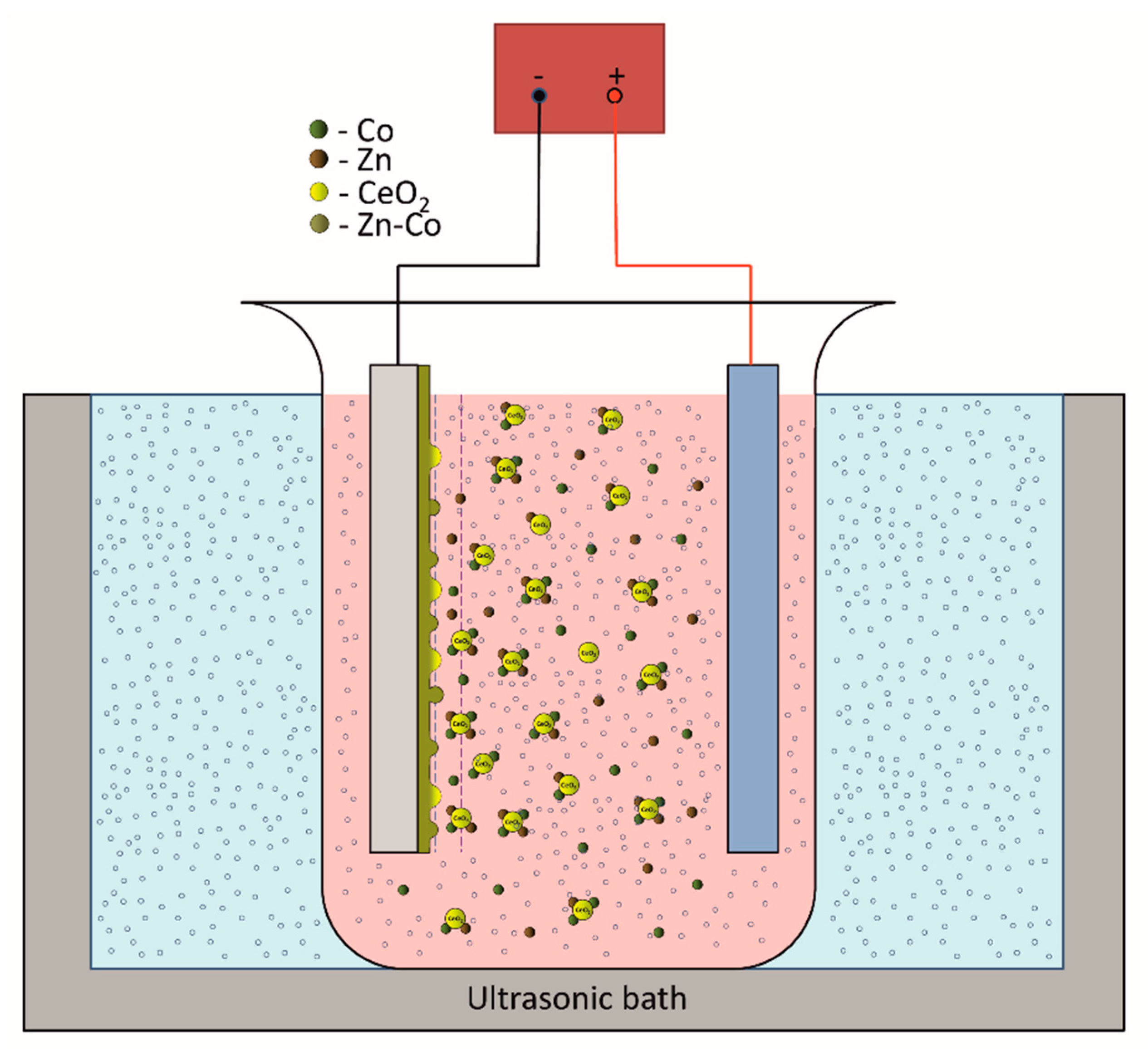
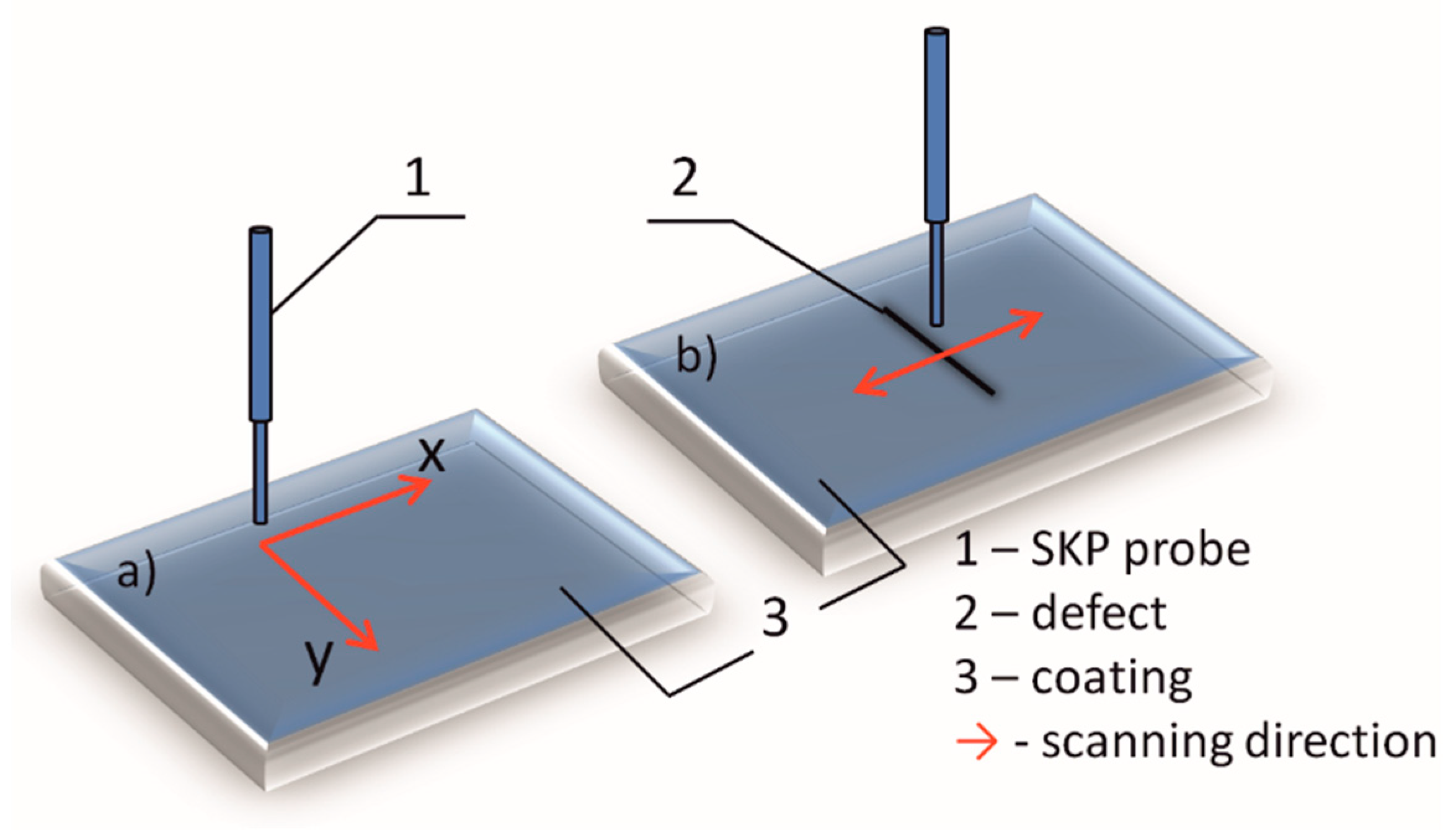

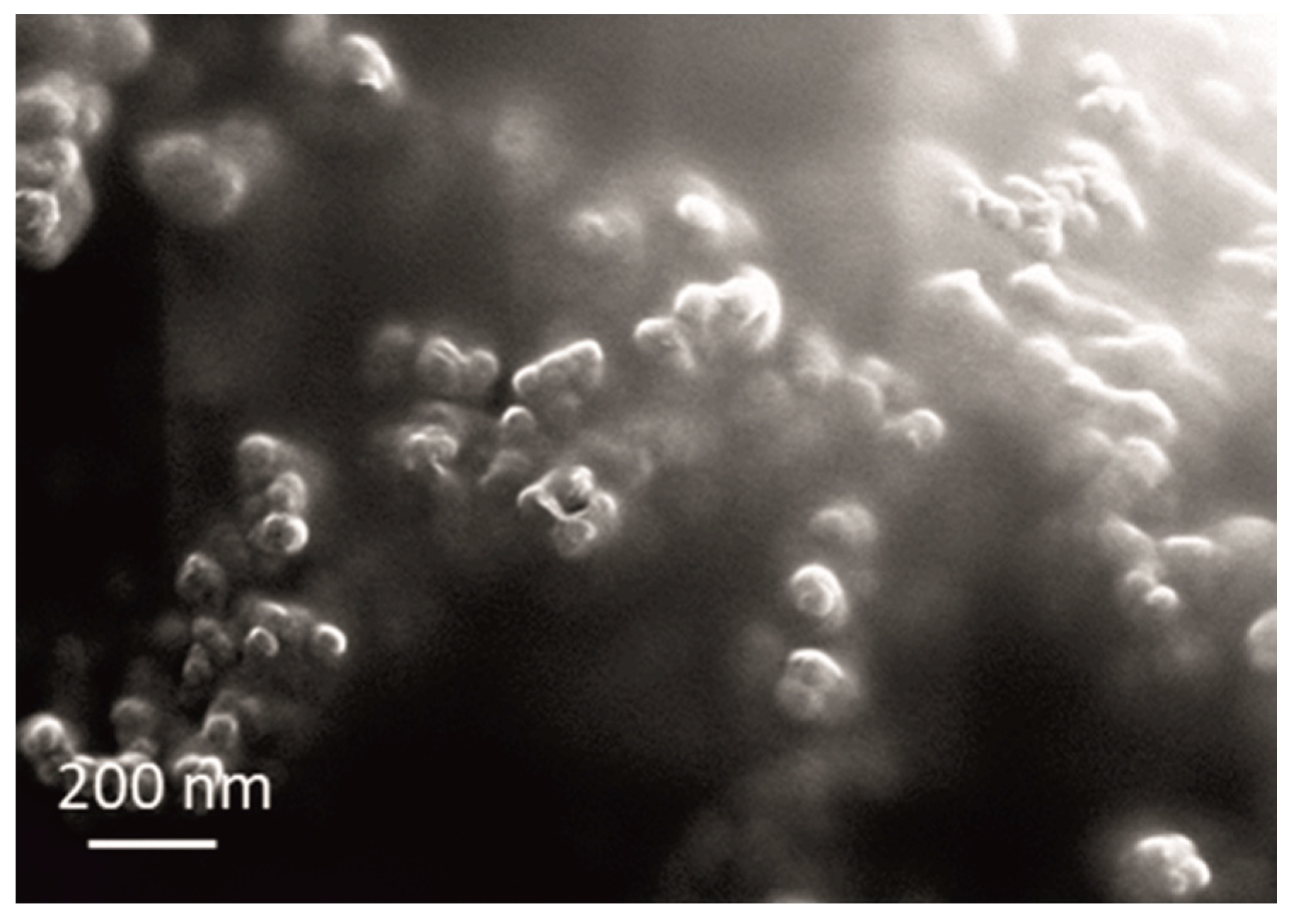
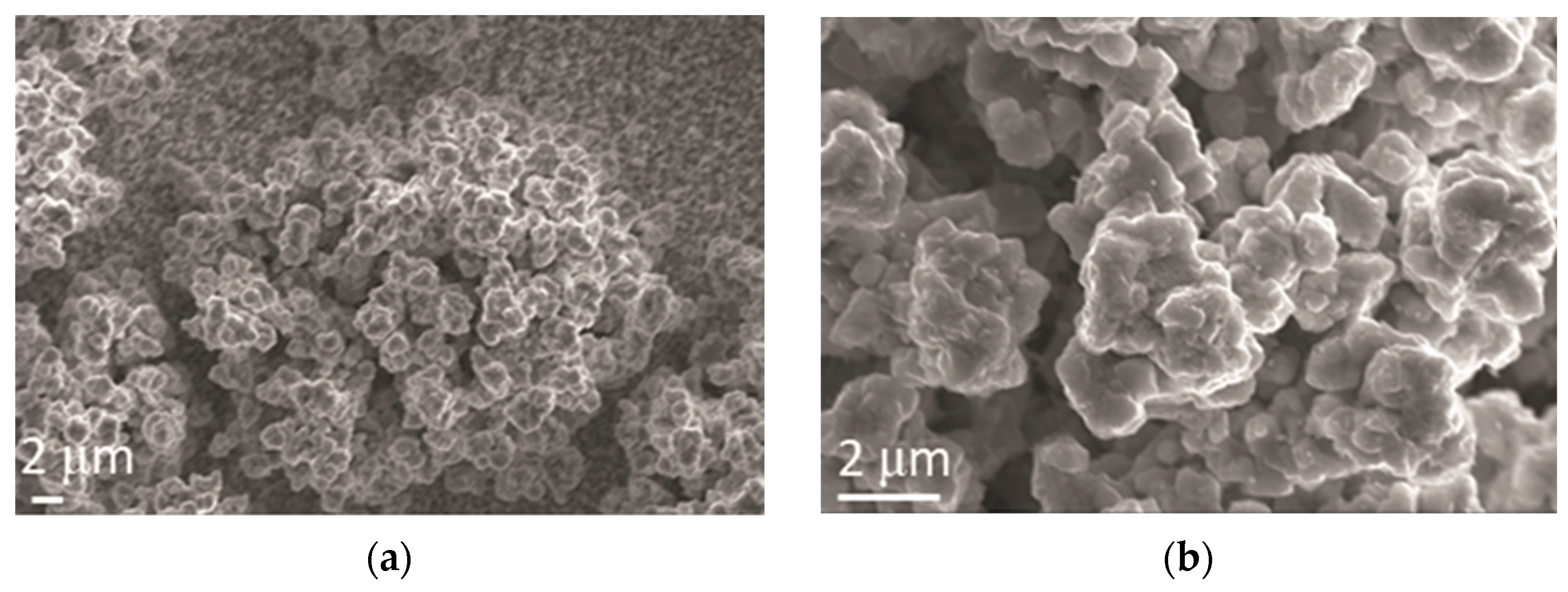
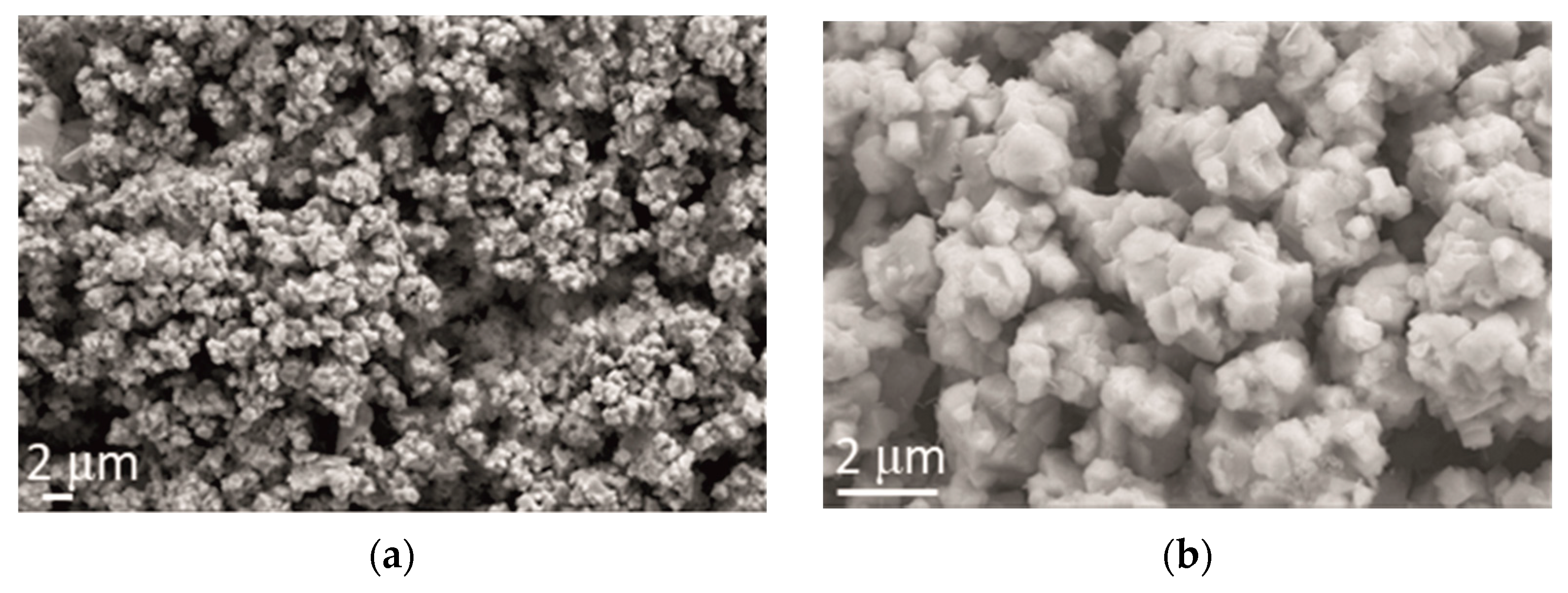
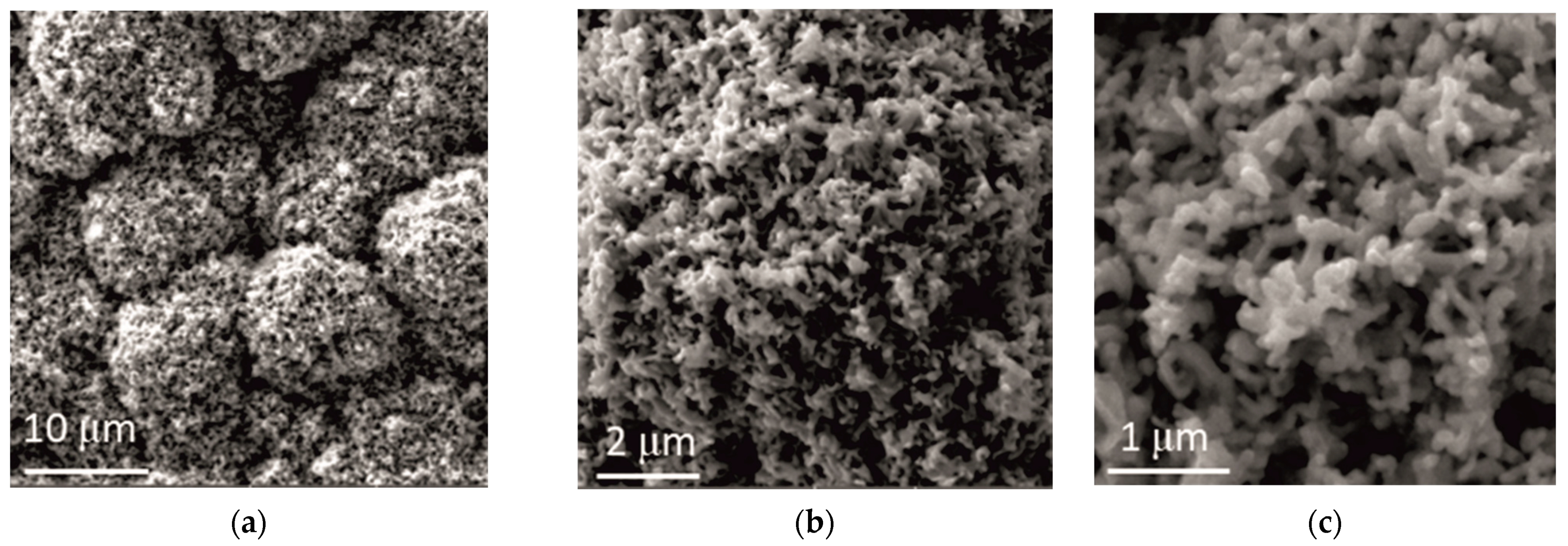

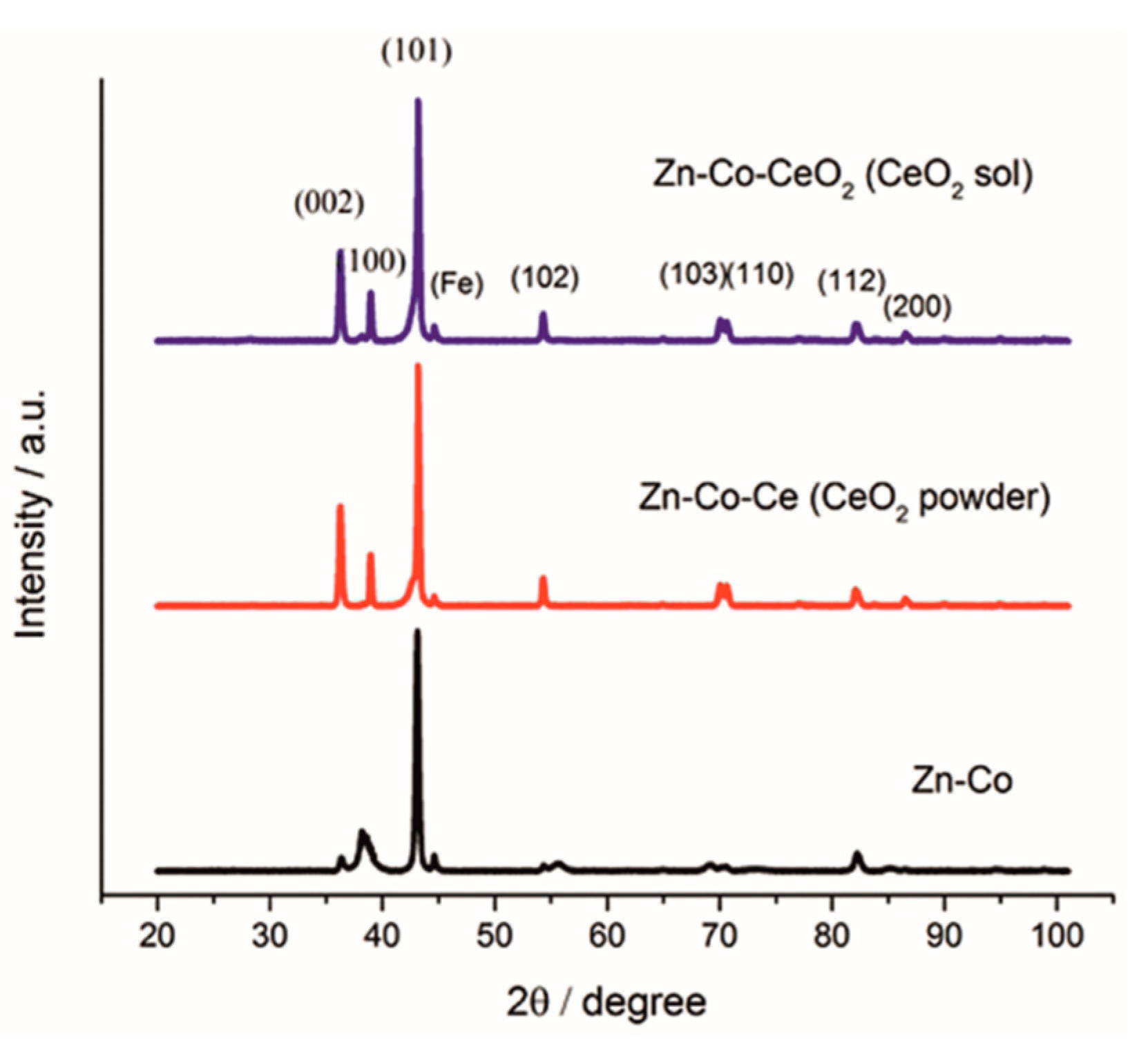
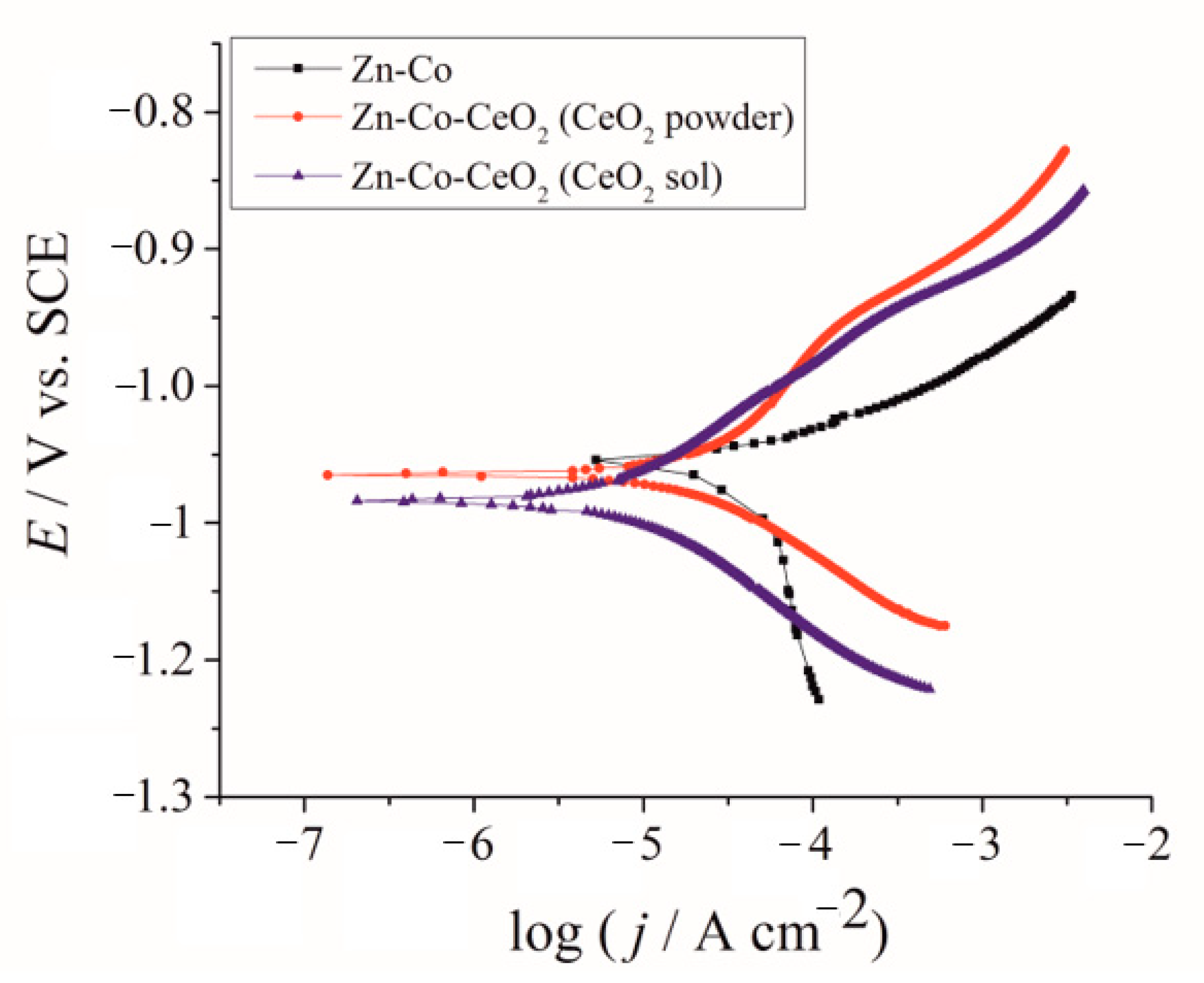
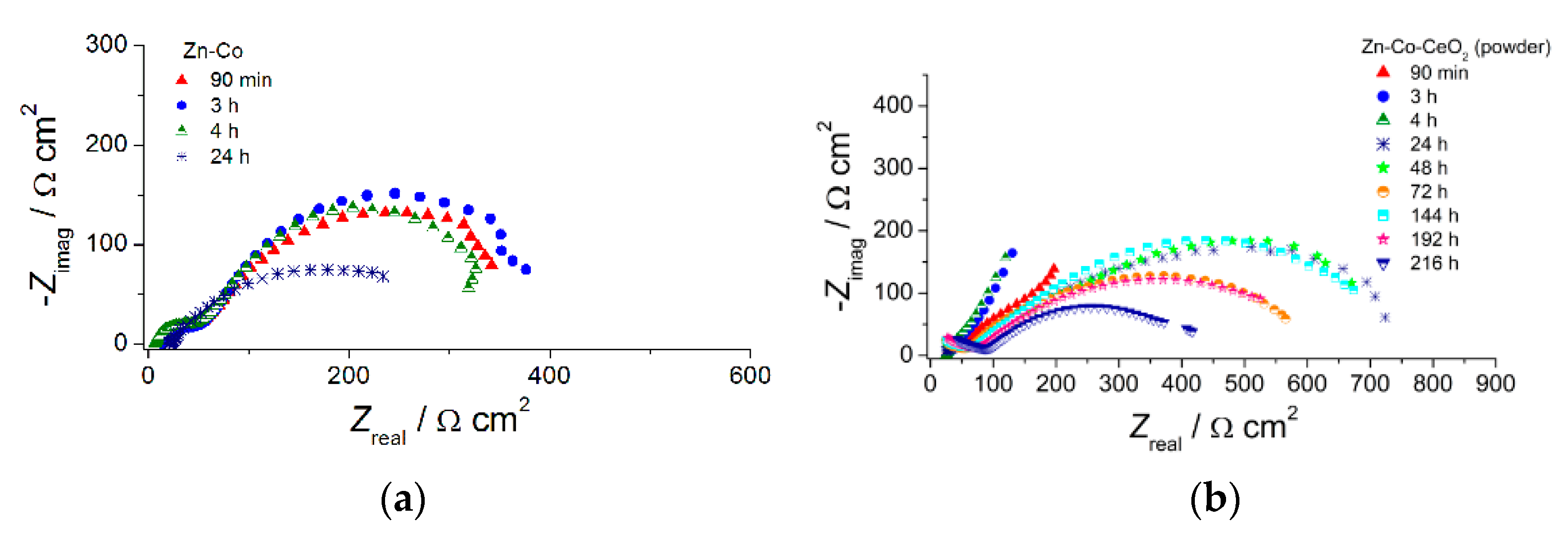
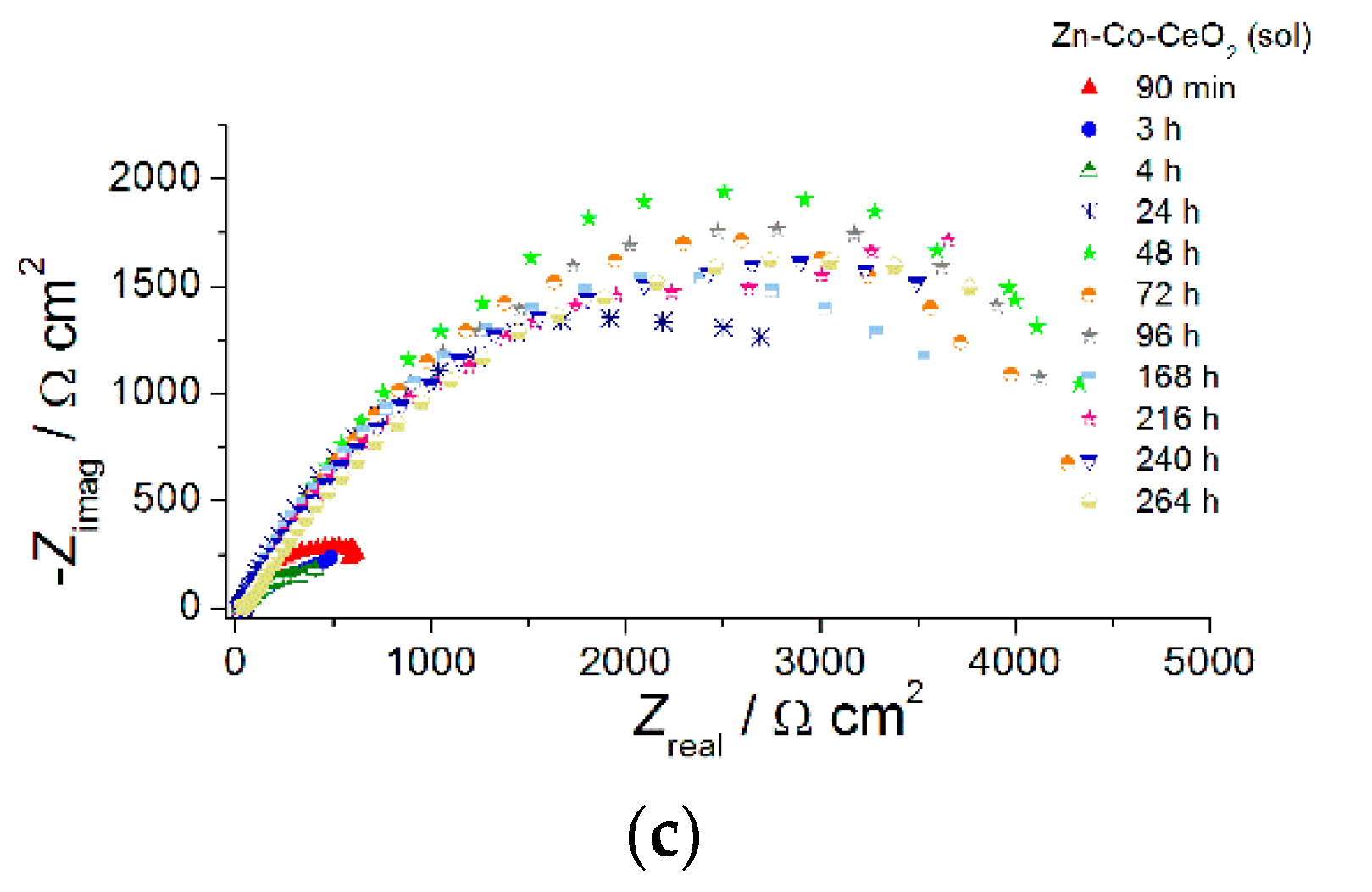
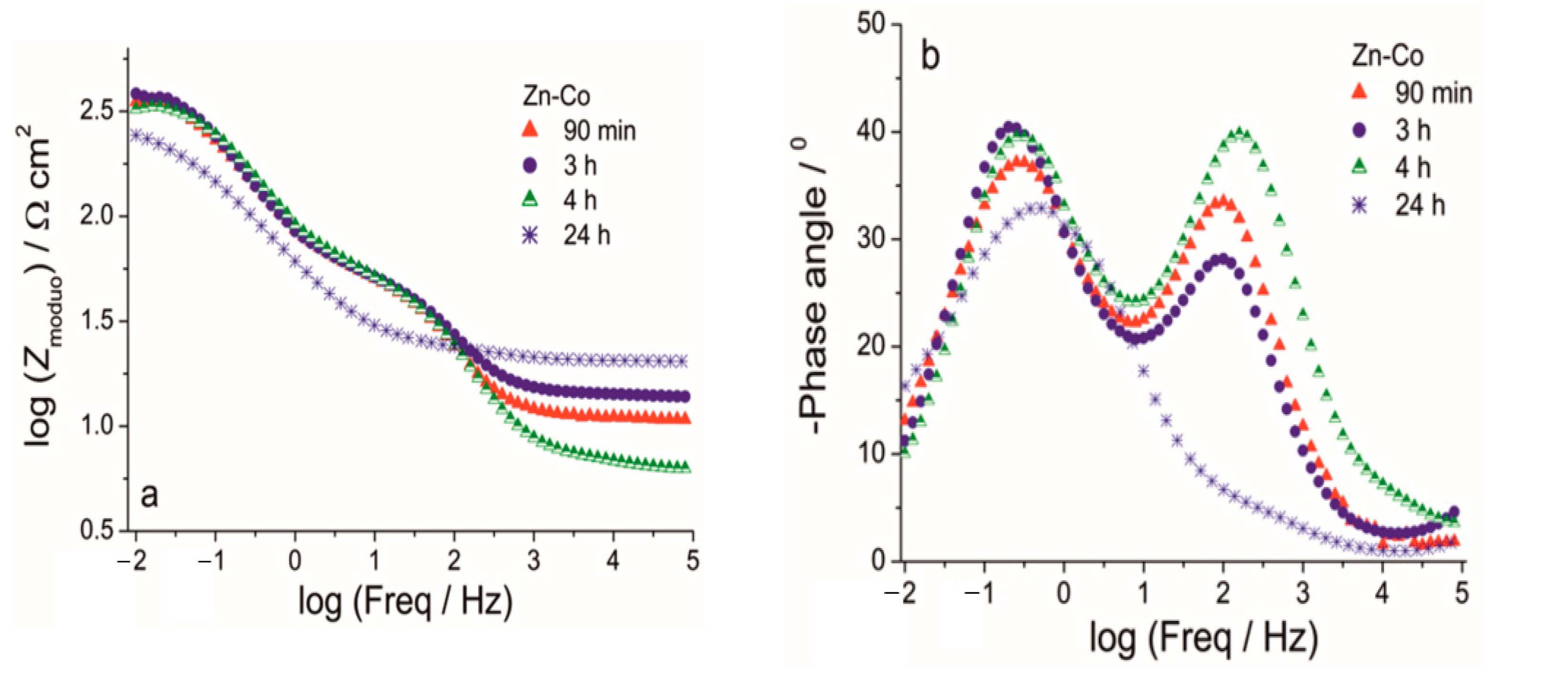
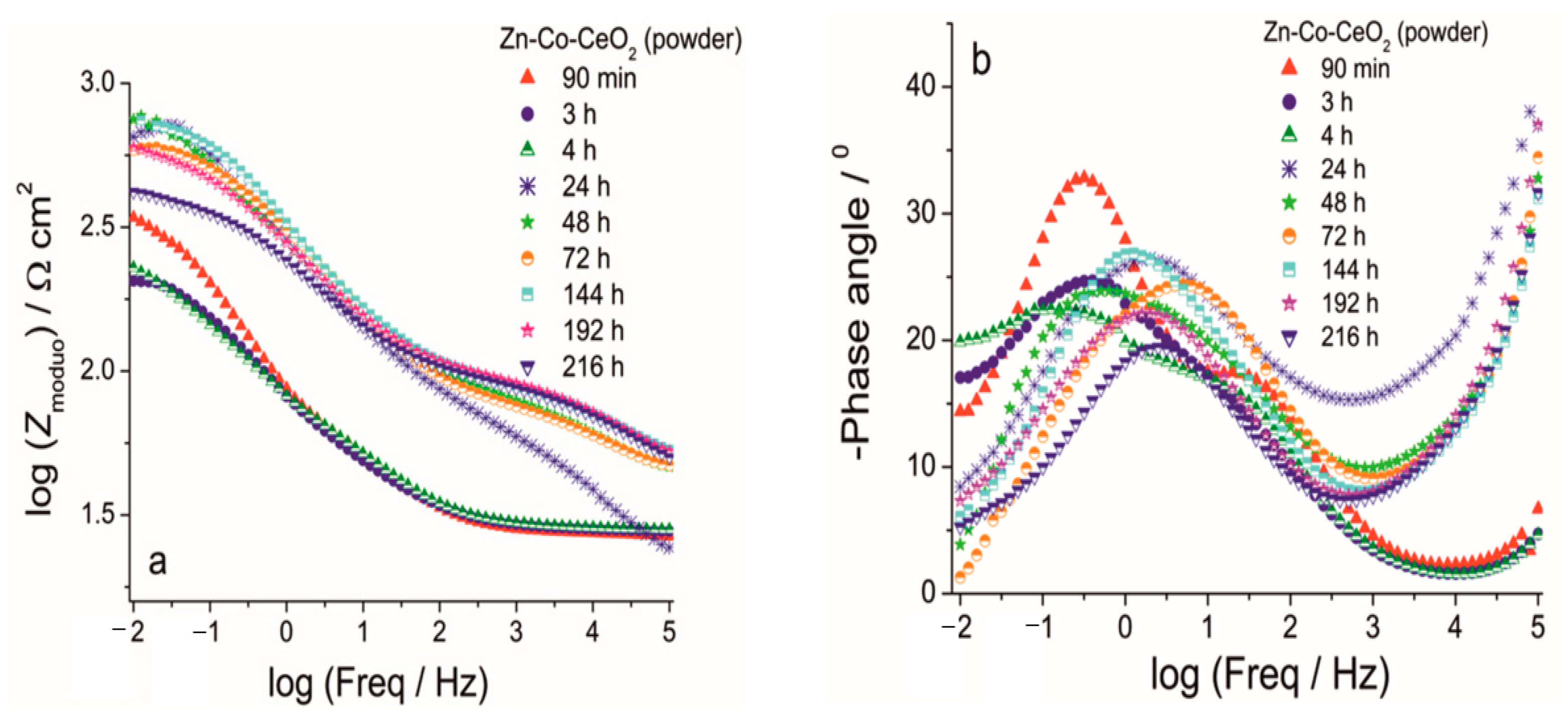
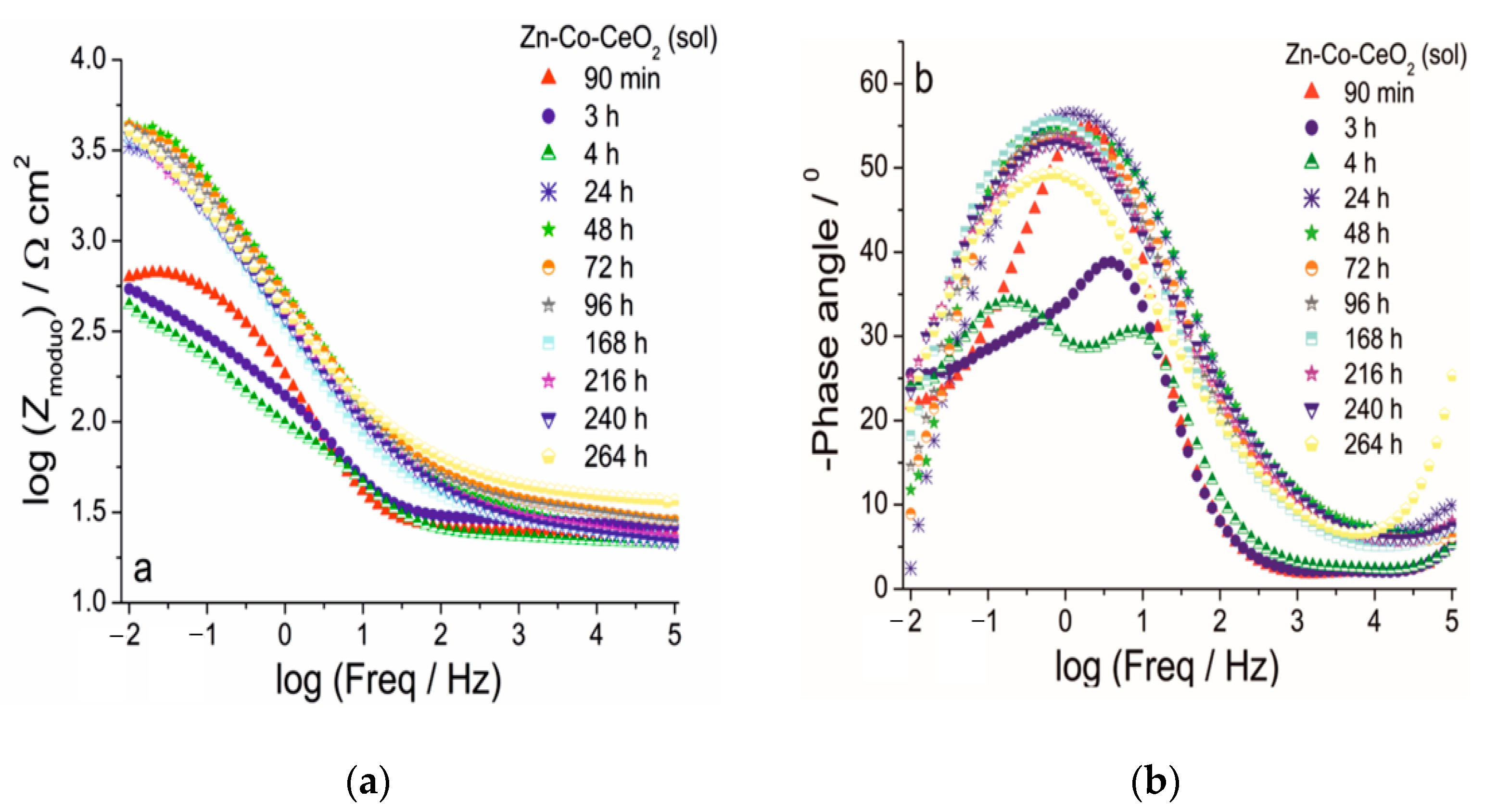
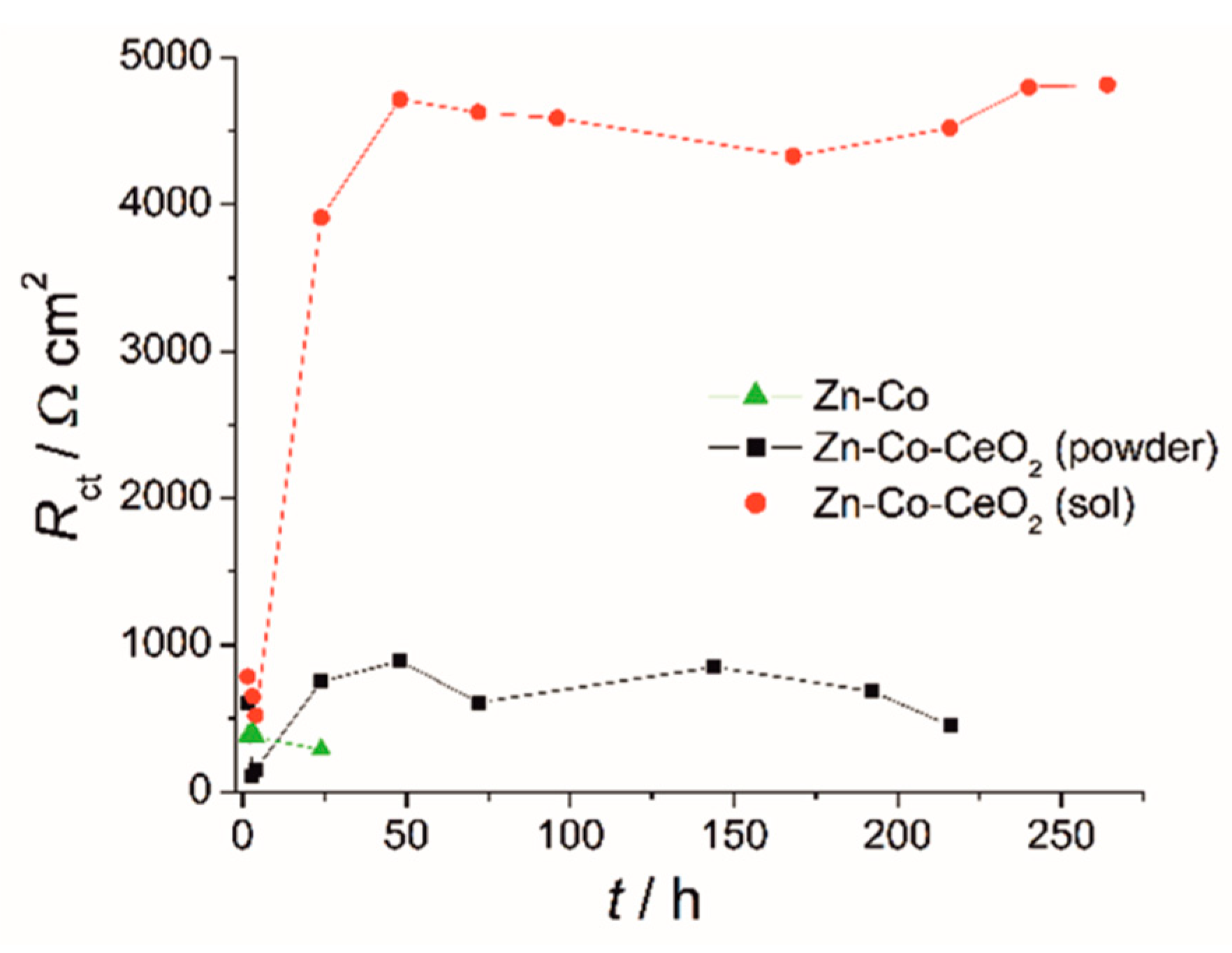
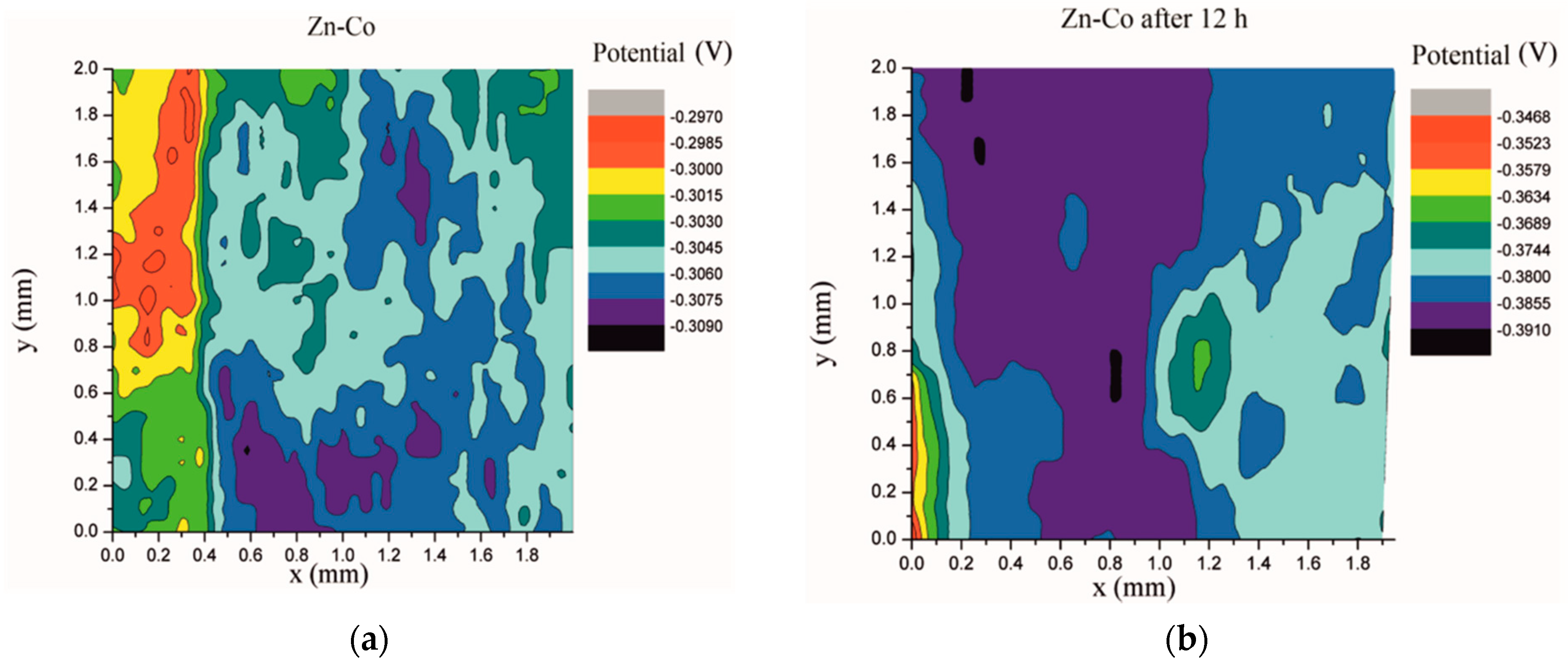
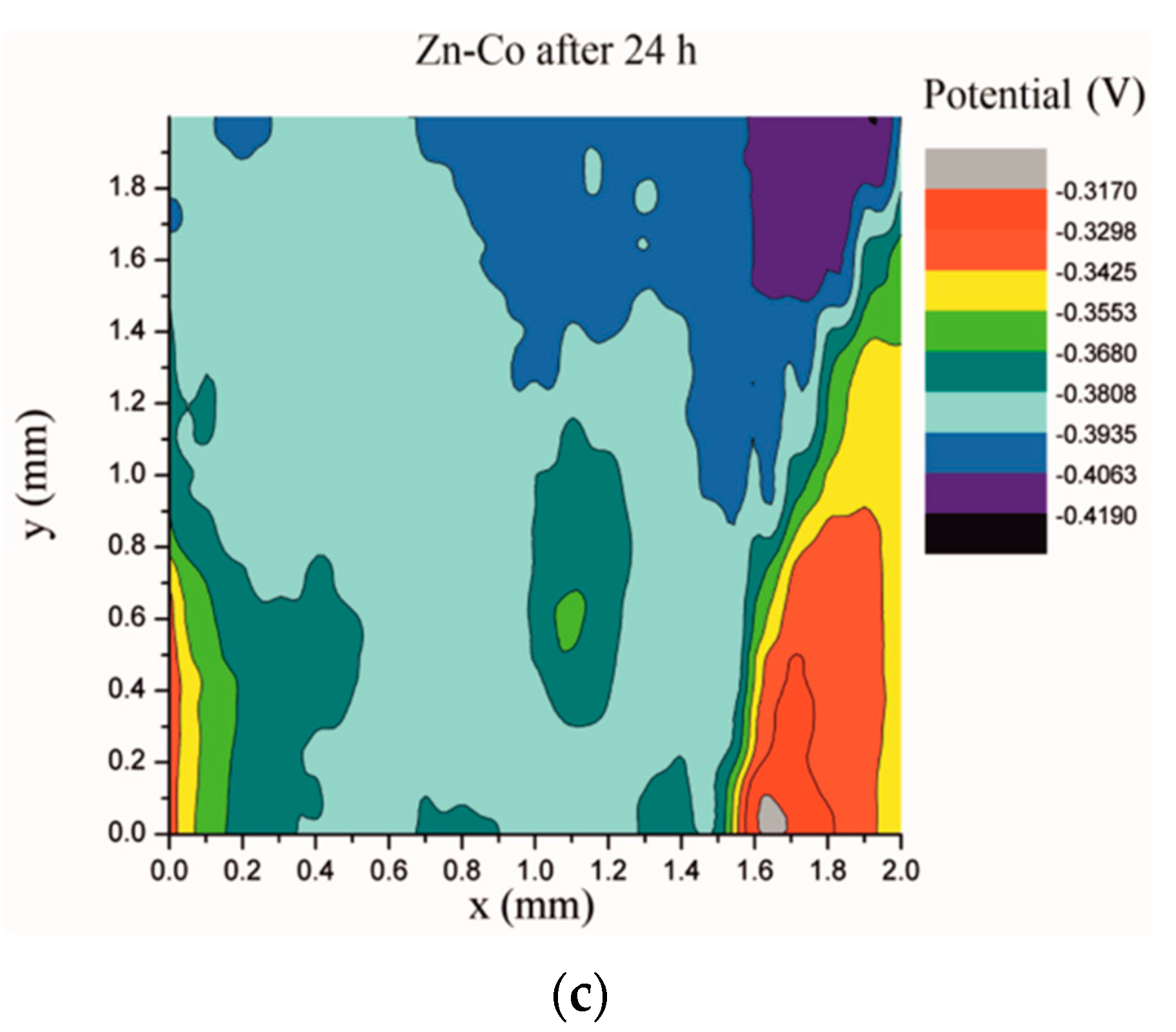
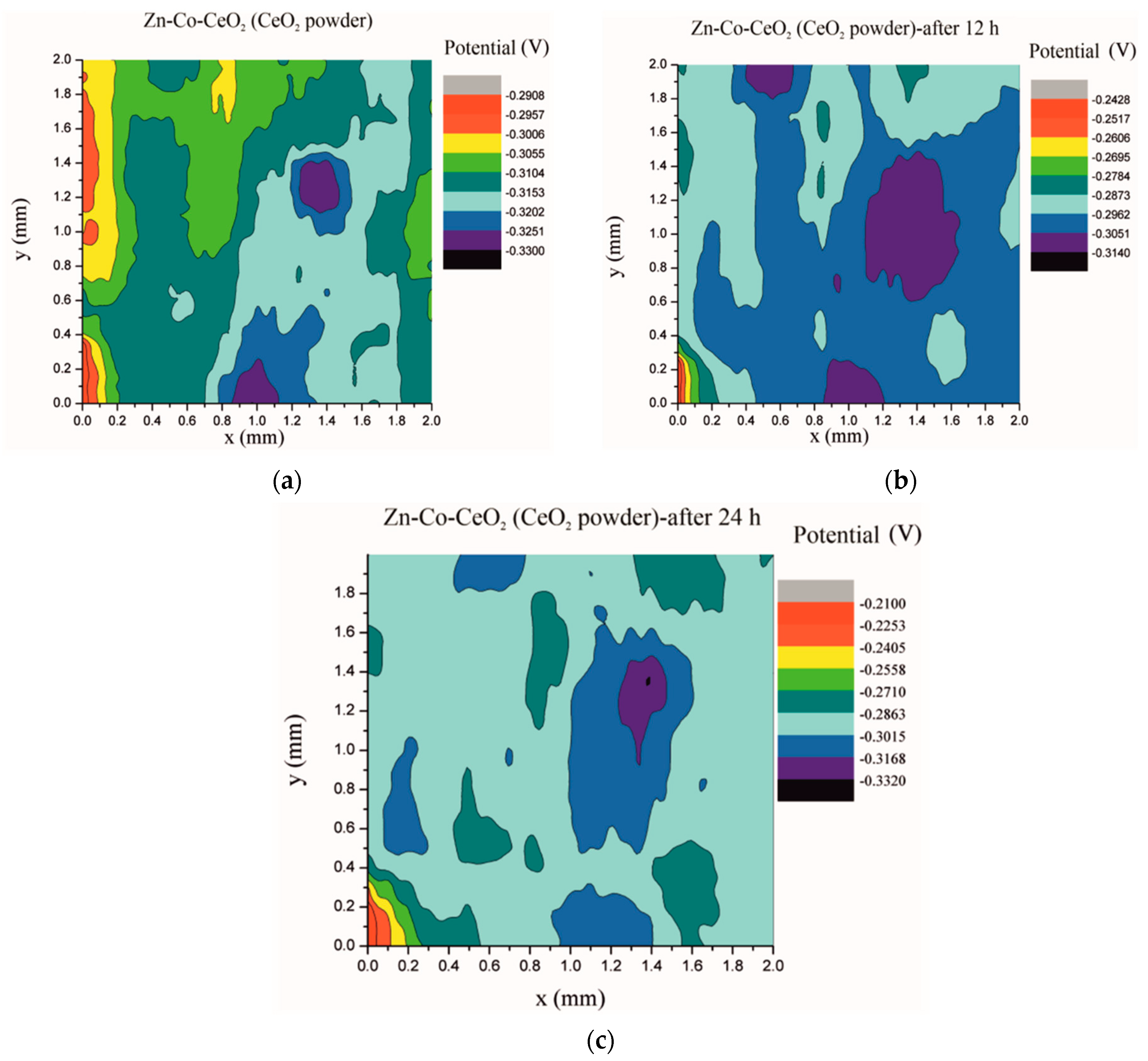

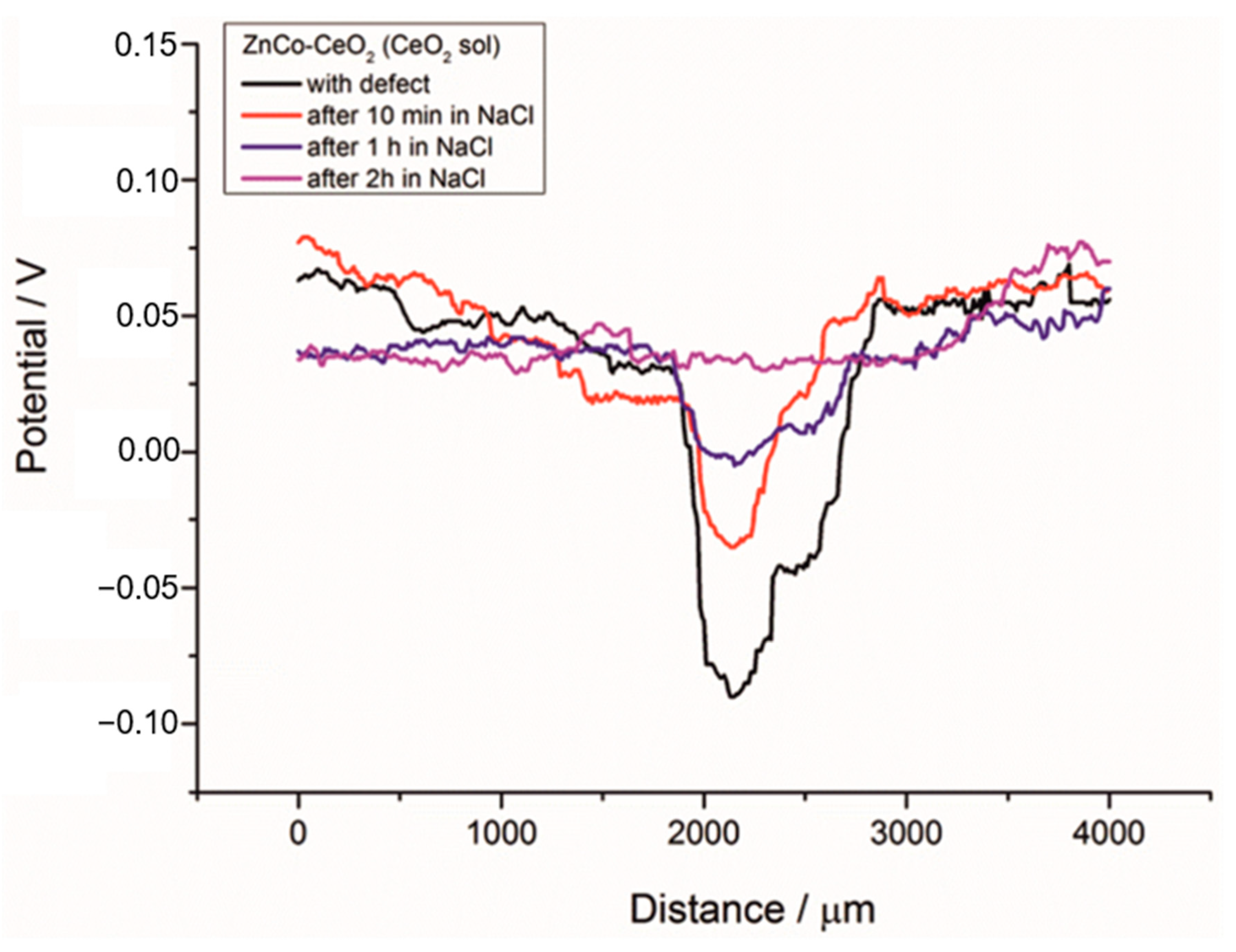
| Elements (wt.%) | Type of Coatings | ||
|---|---|---|---|
| Zn-Co | Zn-Co-CeO2 (CeO2 Powder) | Zn-Co-CeO2 (CeO2 Sol) | |
| Zinc | 96.89 | 94.72 | 92.90 |
| Cobalt | 3.11 | 3.61 | 3.34 |
| Cerium | - | 1.67 | 3.76 |
| Zn-Co | Zn-Co-CeO2 (CeO2 Powder) | Zn-Co-CeO2 (CeO2 sol) | |||
|---|---|---|---|---|---|
| Sz | Sa | Sz | Sa | Sz | Sa |
| 23.5 | 3.7 | 23.4 | 2.4 | 16.4 | 1.6 |
| Sample | –Ecorr /V | jcorr /µA cm–2 |
|---|---|---|
| Zn-Co | 1.055 | 31.0 |
| Zn-Co-CeO2 (powder) | 1.065 | 9.5 |
| Zn-Co-CeO2 (sol) | 1.089 | 5.4 |
Publisher’s Note: MDPI stays neutral with regard to jurisdictional claims in published maps and institutional affiliations. |
© 2021 by the authors. Licensee MDPI, Basel, Switzerland. This article is an open access article distributed under the terms and conditions of the Creative Commons Attribution (CC BY) license (https://creativecommons.org/licenses/by/4.0/).
Share and Cite
Riđošić, M.; Nikolić, N.D.; Salicio-Paz, A.; García-Lecina, E.; Živković, L.S.; Bajat, J.B. Zn-Co-CeO2 vs. Zn-Co Coatings: Effect of CeO2 Sol in the Enhancement of the Corrosion Performance of Electrodeposited Composite Coatings. Metals 2021, 11, 704. https://doi.org/10.3390/met11050704
Riđošić M, Nikolić ND, Salicio-Paz A, García-Lecina E, Živković LS, Bajat JB. Zn-Co-CeO2 vs. Zn-Co Coatings: Effect of CeO2 Sol in the Enhancement of the Corrosion Performance of Electrodeposited Composite Coatings. Metals. 2021; 11(5):704. https://doi.org/10.3390/met11050704
Chicago/Turabian StyleRiđošić, Marija, Nebojša D. Nikolić, Asier Salicio-Paz, Eva García-Lecina, Ljiljana S. Živković, and Jelena B. Bajat. 2021. "Zn-Co-CeO2 vs. Zn-Co Coatings: Effect of CeO2 Sol in the Enhancement of the Corrosion Performance of Electrodeposited Composite Coatings" Metals 11, no. 5: 704. https://doi.org/10.3390/met11050704
APA StyleRiđošić, M., Nikolić, N. D., Salicio-Paz, A., García-Lecina, E., Živković, L. S., & Bajat, J. B. (2021). Zn-Co-CeO2 vs. Zn-Co Coatings: Effect of CeO2 Sol in the Enhancement of the Corrosion Performance of Electrodeposited Composite Coatings. Metals, 11(5), 704. https://doi.org/10.3390/met11050704








